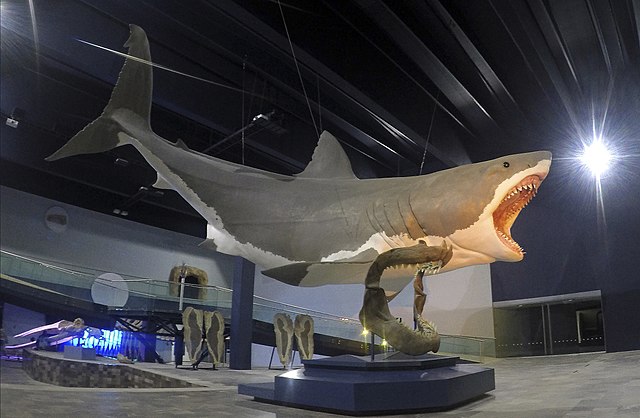
How big was a Megalodon? The largest ones could have been 20 meters long.
Megalodon was a species of giant mackerel shark. Mackerel sharks have two dorsal fins, an anal fin, five gill slits, eyes without nictitating membranes, and a mouth that extends behind the eyes. Great white sharks are in this family. Megalodons lived between 23 million and 3.6 million years ago. They tended to live in warmer water, but some have been found in colder water as well.
There is no way of knowing the exact size of a Megalodon because there are no complete fossils. Many other dinosaurs have been kind enough to become fossils so we can see their size and how they lived. Megalodon didn’t do this because, as a shark, it was made of mostly cartilage. Cartilage decomposes very quickly when sharks die and doesn’t hang around long enough to become a fossil. That isn’t to say that there won’t be a Megalodon fossil, but we’d have to be very lucky. Some soft animals, like jellyfish, live fossilized impressions when they die on something soft, like mud, and there might be an undiscovered Megalodon fossil somewhere, waiting to be discovered. The only parts of the Megalodon that have been discovered are the teeth and some parts of the vertebrae. We have been very lucky to have the vertebrae fossils, but the teeth are far more common.
Megalodon was a shark and sharks lose their teeth all of the time. When we are born, we have our “milk” teeth, which are replaced by the adult teeth that we keep throughout our lives. If we lose our teeth, that is it. Sharks need very sharp teeth to be able to rip and tear their prey. They also lose a lot of teeth when they are attacking their prey because they can be knocked out. To keep them sharp, and to replace the teeth that are knocked out, sharks replace their teeth all the time. Megalodon probably had 250 teeth spread over 5 rows. They probably replaced these teeth every week and thousands of teeth lay at the bottom of the sea. Sharks lose about 35,000 teeth in their lifetime, so there are probably millions of fossilized Megalodon teeth at the bottom of the sea. The teeth are the only part of a shark that are made of bone and they are covered in an enamel that protected them and ensured that so many of them would be fossilized.
So, how big was the Megalodon? The only way to work that out is to look at the teeth and try to extrapolate out. That is a very difficult, but not impossible task to do. If an archaeologist found a human tooth after we had gone extinct, they could probably work out our rough size by looking at how many teeth we could fit in our mouths and how powerful they were. Experts have done the same thing with Megalodon teeth. They can see by the shapes and size of them how many would fit in a mouth, and they can compare that to modern great white sharks. The two animals were probably of a similar shape. Analysis of the teeth gives a probably maximum size of about 20 meters. Many of them would have been smaller, but some could have been bigger.
Most of them were probably smaller than 20 meters because the extra size is not really worth it for the shark. Up to a certain point, they get many benefits from being larger. They are more powerful, they can hunt more food, they are able to regulate their body temperature more efficiently, they can swim faster, and so on. However, if they are too large, they will be extremely heavy, which would slow them down. A 20 m shark would have weighed over 100 tons, which would have made them less maneuverable. They would also have had trouble finding enough food. A 20 meter shark would need about 100,000 calories a day. That was probably possible, but it would have been difficult to sustain. Their sheer size gave them phenomenally strong jaws as well. A modern great white shark has a bite strength of about 18,000 Newtons. The Megalodon probably has a bite force of 182,000 Newtons.
Megalodons went extinct about 3.6 million years ago. Their size might have been one of the reasons for this. Just like when the dinosaurs went extinct, the animals that were able to hide and survive on less food survived, while the dinosaurs that needed to eat a lot died off. Probably, there was a food shortage and the Megalodons couldn’t get enough to feed themselves. 3.6 million years ago was when the seas started to cool down and there was an ice age. Megalodons lived in warmer water, so their territory decreased, but their food also disappeared as well. About 60% of all marine life died out during this time. The largest animals were the first to go extinct because they couldn’t feed themselves. And this is what I learned today.
Image By Sergiodlarosa – Own work, CC BY-SA 4.0, https://commons.wikimedia.org/w/index.php?curid=71545069
Sources
https://en.wikipedia.org/wiki/Megalodon
https://www.nhm.ac.uk/discover/megalodon–the-truth-about-the-largest-shark-that-ever-lived.html
https://www.fossilera.com/pages/megalodon-size
https://www.britannica.com/animal/megalodon/Extinction
https://en.wikipedia.org/wiki/Shark_tooth

[…] Article from: https://ilearnedthistoday.com/index.php/2024/03/19/how-big-was-a-megalodon/ […]